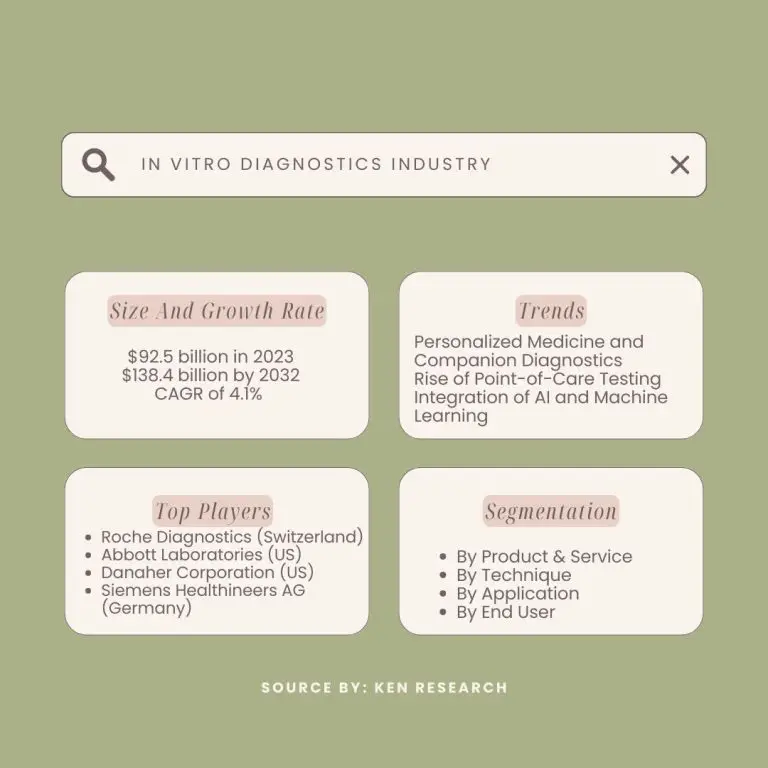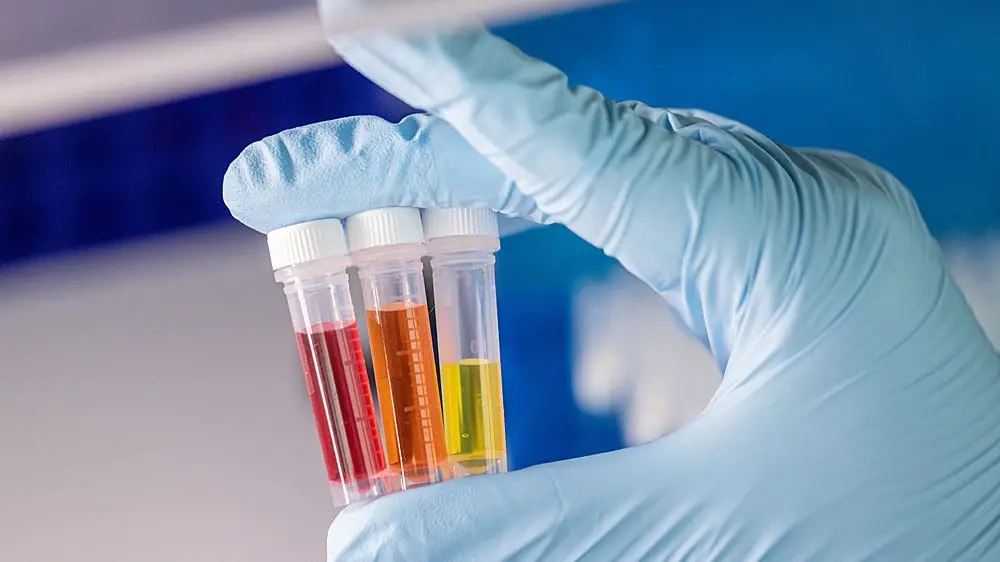
The Global In Vitro Diagnostics Market was valued at $92.5 billion in 2023 and is projected to reach a staggering $138.4 billion by 2032. This growth reflects a compound annual growth rate (CAGR) of 4.1% from 2023 to 2032. The continuous demand for advanced diagnostic tools underscores the vital role of IVD in enhancing patient care and healthcare outcomes.
In Vitro Diagnostics Market Trends
Here are some of the key trends in the In Vitro Diagnostics Industry
Personalized Medicine and Companion Diagnostics
Personalized medicine tailors treatment plans to individual patient profiles, significantly impacting the In Vitro Diagnostics Market. Companion diagnostics, which identify suitable therapies for patients, are essential for personalized treatment, enhancing efficacy and reducing healthcare costs.
Rise of Point-of-Care Testing
POC testing allows for immediate diagnostic results, facilitating prompt medical decisions. This trend is particularly beneficial in remote or resource-limited settings, driving the adoption of POC diagnostics globally.
Integration of AI and Machine Learning
Artificial intelligence (AI) and machine learning (ML) are transforming IVD by improving test accuracy and predictive capabilities. These technologies assist in interpreting complex data, enhancing diagnostic precision and patient care.
Expansion of Molecular Diagnostics
Molecular diagnostics play a crucial role in genomics, infectious disease detection, and cancer management. The expansion of this segment is driven by its application in personalized medicine and its ability to provide detailed insights into disease mechanisms.
Growth of In Vitro Diagnostics Industry
The In Vitro Diagnostics Sector is a complex landscape with various forces driving and restraining its growth.
Key Drivers of Market Growth
Several factors fuel the growth of the In Vitro Diagnostics Market Sector. The rise in chronic and infectious diseases, technological advancements, and an aging population are primary drivers. Chronic diseases like cardiovascular ailments and cancer necessitate early and accurate diagnostics, boosting the demand for IVD tests.
Impact of Chronic and Infectious Diseases
Chronic diseases and infections remain a significant burden on global health. IVD tests are crucial for early detection, monitoring, and management of these conditions, driving market demand. For instance, timely HIV testing can prevent disease progression and transmission.
Technological Advancements
Innovations in technology have significantly enhanced the efficiency and accuracy of IVD tests. Developments in molecular diagnostics, next-generation sequencing, and point-of-care (POC) testing have revolutionized disease detection and management. These advancements enable faster, more precise diagnostics, improving patient outcomes.
Aging Population and Healthcare Demands
The global aging population is another critical factor driving In Vitro Diagnostics Industry Growth. Older adults are more susceptible to chronic diseases, necessitating regular diagnostic testing. This demographic trend ensures a sustained demand for IVD services.
Top Players in In Vitro Diagnostics Market
Here are some of the top players in the In Vitro Diagnostics Industry
- Roche Diagnostics (Switzerland): A global leader in diagnostics, offering a wide range of IVD tests across various disease areas. They are known for their innovative products and strong brand recognition.
- Abbott Laboratories (US): Another major player with a broad IVD portfolio, including immunodiagnostics, molecular diagnostics, and rapid tests. Abbott is a leader in point-of-care testing and blood glucose monitoring systems.
- Danaher Corporation (US): A science and technology innovator with a significant presence in IVDs through its subsidiary, Beckman Coulter Diagnostics. They offer a comprehensive range of instruments, assays, and consumables for clinical laboratories.
- Siemens Healthineers AG (Germany): A leading medical technology company with a strong presence in IVDs. They offer a wide range of diagnostic imaging, laboratory diagnostics, and point-of-care testing solutions.
- Thermo Fisher Scientific (US): A world leader in scientific instrumentation, offering a comprehensive range of IVD products, including instruments, reagents, and consumables. They are known for their strong research and development capabilities.
Challenges in In Vitro Diagnostics Sector
The In Vitro Diagnostics (IVD) market, despite its growth, faces several challenges that can hinder its progress.
Regulatory Stringency
- Strict approval processes: Obtaining regulatory approvals for new IVD technologies can be a lengthy and expensive process. This can stifle innovation and delay the introduction of new diagnostic tools to the market.
- Reimbursement limitations: Government and insurance agencies often have strict criteria for reimbursing IVD tests. This can limit the adoption of new tests, especially if they are considered expensive compared to existing options.
Economic Pressures
- Cost containment measures: Healthcare systems are constantly looking for ways to control costs. This can put pressure on IVD manufacturers to lower their prices, which can impact their profitability.
- Competition and consolidation: The IVD market is becoming increasingly consolidated, with a few large players dominating the market. This can limit competition and potentially lead to higher prices for IVD products.
Technological and Operational Challenges
- Cybersecurity threats: The increasing reliance on digital tools and data in IVDs raises concerns about data security breaches and cyberattacks. These can disrupt operations and potentially compromise patient data.
- Skilled labor shortage: Operating and interpreting advanced IVD technologies may require specialized skills. A shortage of qualified personnel, particularly in developing regions, can hinder the adoption and effective utilization of new diagnostic tools.
- Operational complexities: Integrating new IVD technologies into existing laboratory workflows can be challenging. Additionally, ensuring efficient and cost-effective operation of these technologies requires ongoing investment in infrastructure and training.
Read Also:- The $131 Billion In Vitro Diagnostics Market, Industry Segments and Trends
In Vitro Diagnostics Market Segmentation
The In Vitro Diagnostics (IVD) Industry is a multifaceted industry segmented based on various criteria to understand market trends and target specific areas. Here's a breakdown of the key segmentation factors:
By Product & Service
- Reagents & Kits: These are the chemical substances and tools used to perform IVD tests. They constitute a major segment due to their recurring use in various diagnostic procedures.
- Instruments: This segment includes sophisticated devices like analyzers used in laboratories to conduct IVD tests.
- Software & Services: This segment encompasses data analysis software, IT solutions for laboratory workflow management, and professional services like test design and validation.
By Technique
- Immunodiagnostics: This technique utilizes antibodies to detect antigens (foreign substances) in the body, aiding in diagnosing infections and autoimmune diseases.
- Clinical Chemistry: This segment focuses on analyzing blood and other body fluids to assess organ function and identify potential abnormalities.
- Molecular Diagnostics: This technique analyzes genetic material (DNA or RNA) for identifying pathogens, inherited diseases, and potential cancer risks.
- Hematology: This segment deals with analyzing blood cells to diagnose blood disorders like anemia and leukemia.
- Other Techniques: This includes emerging technologies like cytogenetics (chromosome analysis) and rapid tests.
By Application
- Infectious Diseases: IVDs play a crucial role in diagnosing various infectious diseases like COVID-19, influenza, and HIV.
- Cancer Diagnostics: IVDs are used for cancer screening, diagnosis, and monitoring treatment response.
- Cardiac Diseases: Diagnostic tests help assess heart health and identify risks for heart attacks and strokes.
- Other Applications: This segment includes IVDs for diagnosing immune system disorders, kidney diseases, and gastrointestinal issues.
By End User
- Hospitals & Clinics: Hospitals and clinics are the primary users of IVDs, employing them for a wide range of diagnostic purposes.
- Clinical Laboratories: Independent laboratories provide diagnostic services and rely heavily on IVDs.
- Blood Banks: IVDs are used for blood screening and ensuring blood safety.
- Home Care Settings: The rise of point-of-care testing (POCT) allows for IVD use in home settings for specific applications.
- Other End Users: This segment includes research institutions, pharmaceutical companies, and academic institutes that utilize IVDs for research and development purposes.
By Geography
- North America: Currently holds the largest market share due to established healthcare infrastructure and high technology adoption.
- Europe: A significant market with stringent regulations and a focus on advanced diagnostics.
- Asia Pacific: The fastest-growing region due to rising disposable incomes, increasing disease burden, and improving healthcare infrastructure.
- Latin America: An emerging market with growth potential due to economic development and government initiatives to improve healthcare access.
Conclusion
The in vitro diagnostics market is poised for significant growth, driven by technological advancements, an aging population, and the rising prevalence of chronic diseases. Despite challenges such as regulatory hurdles and economic factors, the future looks promising with numerous opportunities for expansion and innovation.





